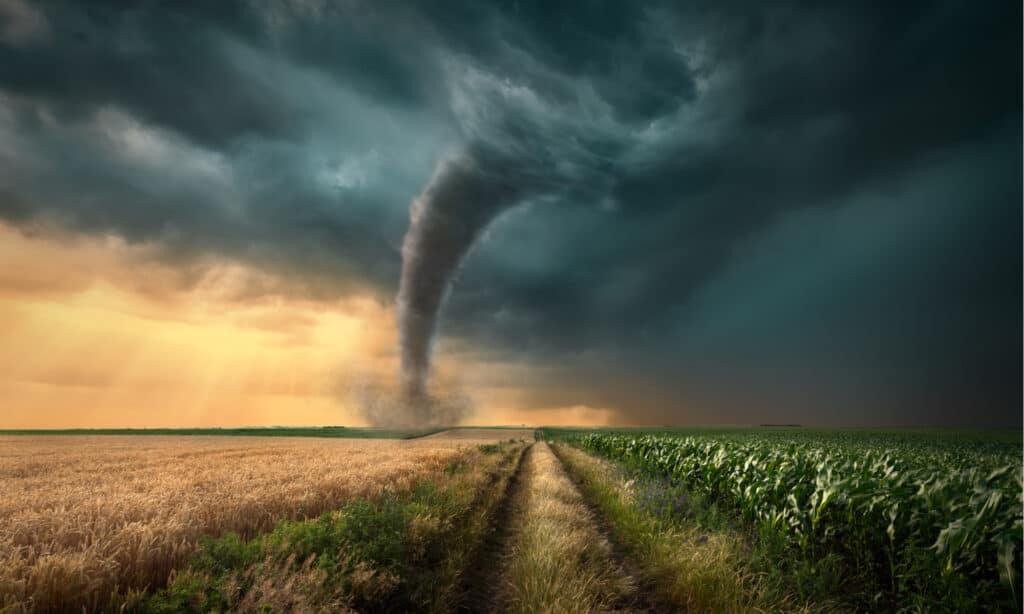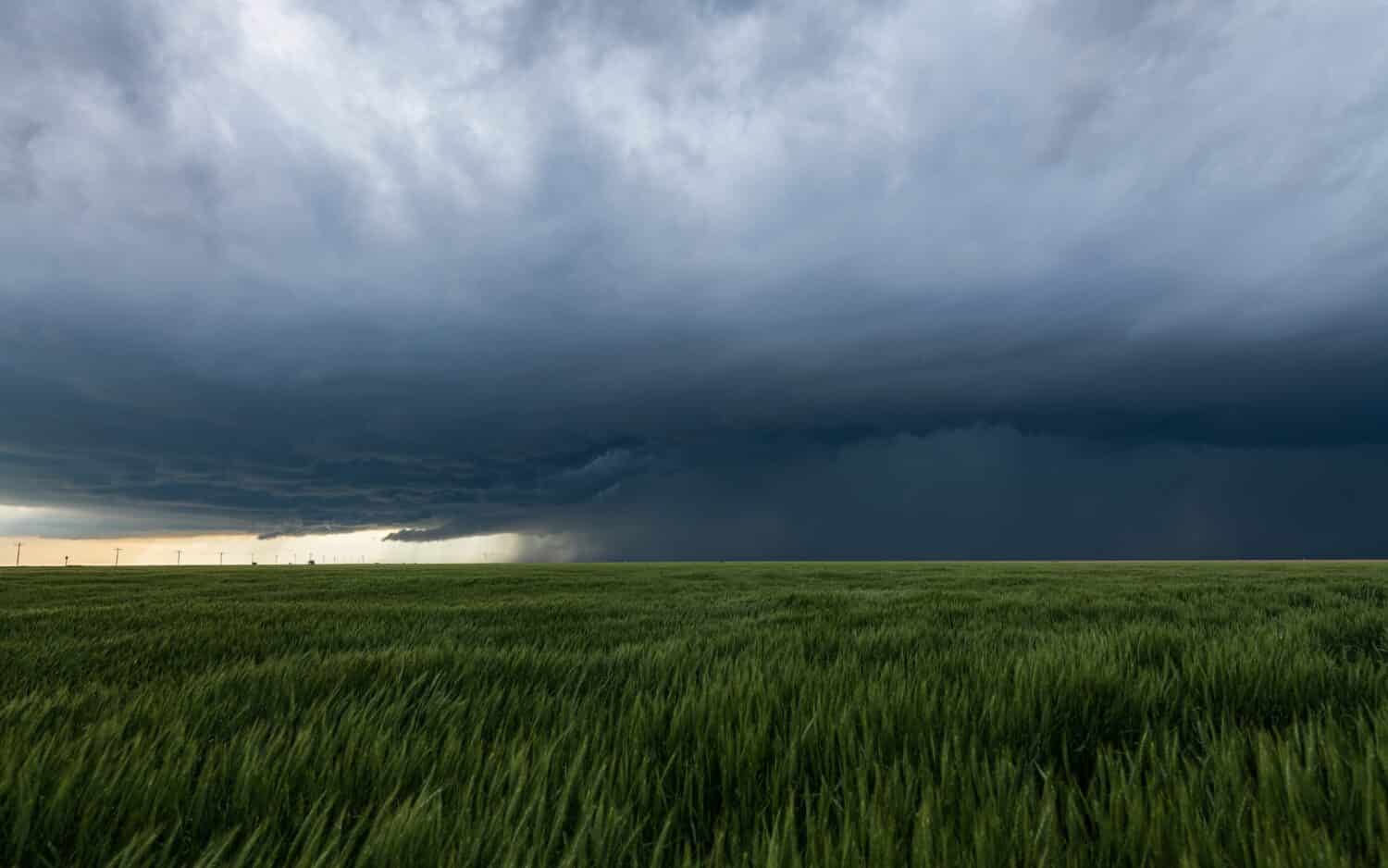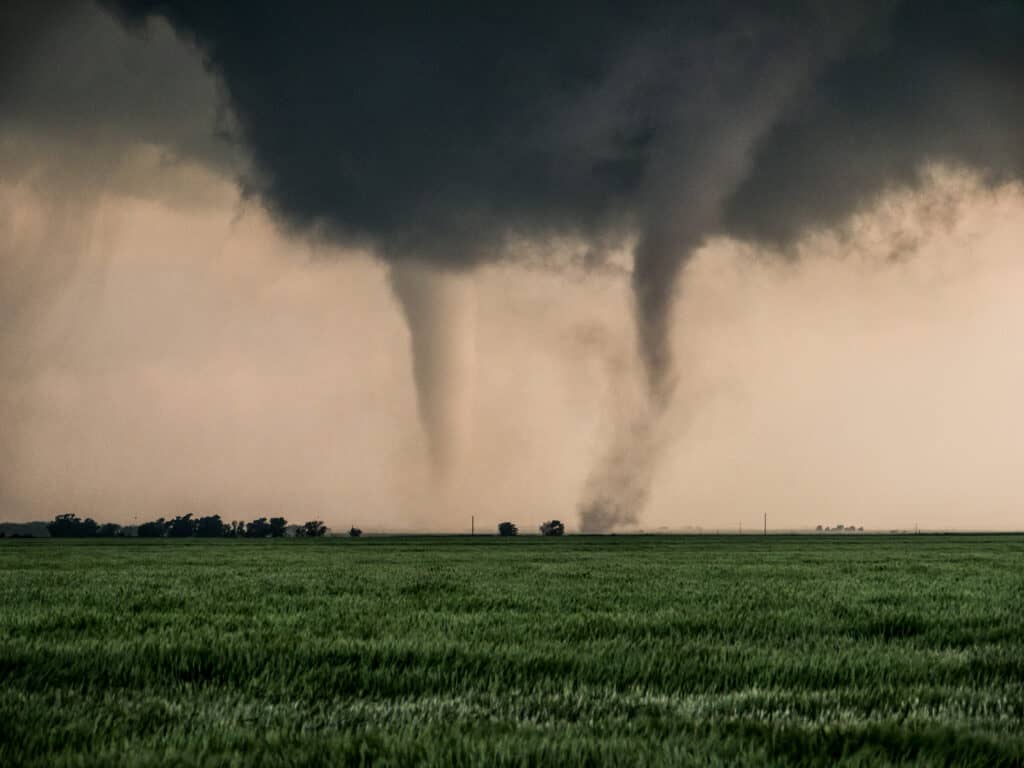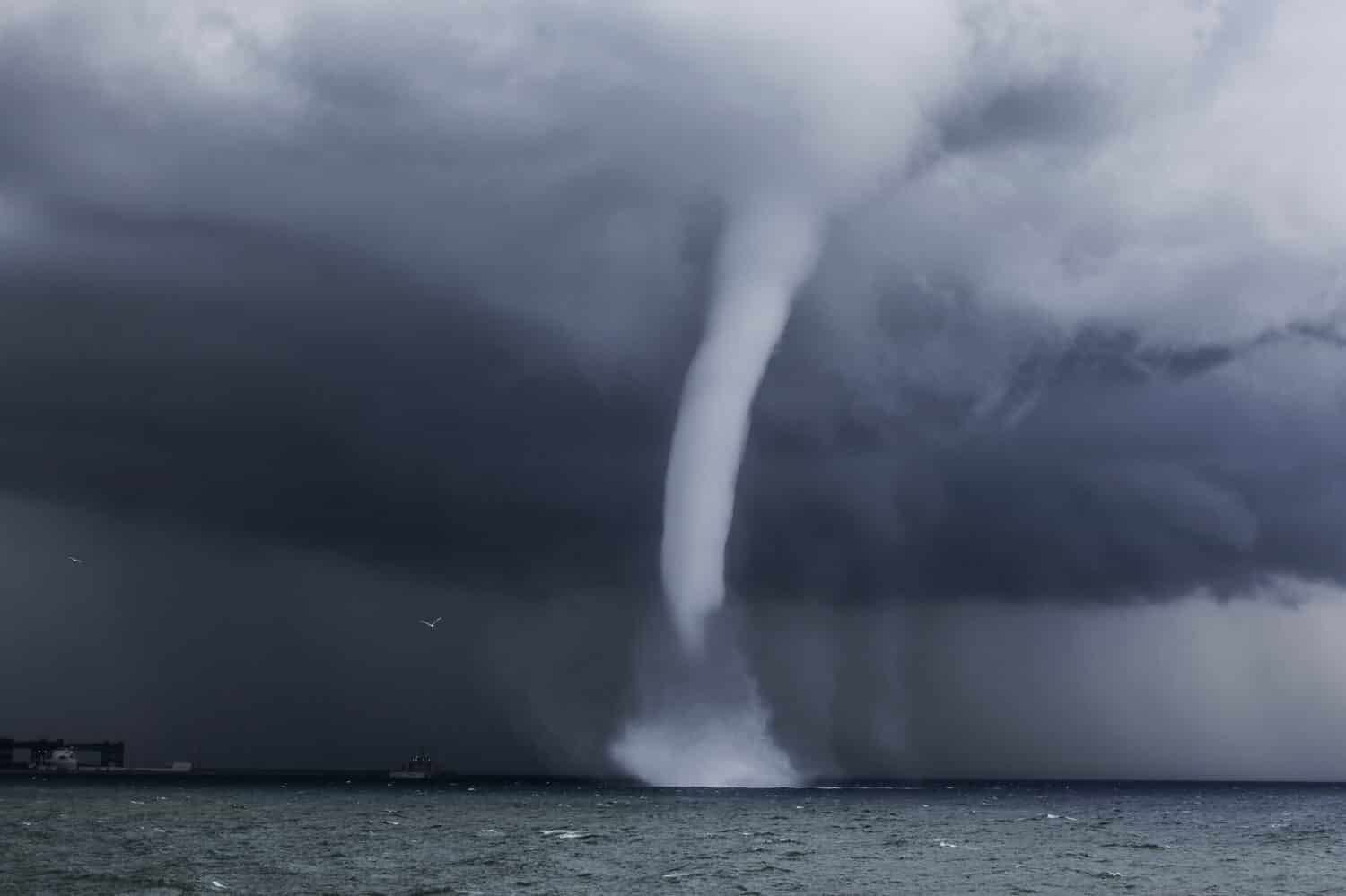In the United States, the power of nature often manifests itself through the awe-inspiring yet potentially dangerous phenomena known as tornadoes. On average, there are 1,200 tornadoes across the country each year, unfortunately leading to approximately 80 deaths and 1500 injuries. These formidable twisters can strike at any time, day or night, and throughout all seasons of the year. Understanding the different types of tornadoes and how to safeguard yourself and your loved ones is absolutely crucial. In the following article, we will discuss the most important tornado types and their characteristics and provide vital safety tips.
But first, a disclaimer before we jump in:
The below information should not be considered as professional advice or a guarantee of safety during a tornado. It is crucial to understand that tornadoes are unpredictable and can pose significant risks. While extremely violent EF5 tornadoes are rare, it is essential to treat all tornado possibilities seriously. The frequency and intensity of tornadoes vary, and local authorities should always be consulted for verified warnings in a given area. Prioritizing safety and following official guidance is absolutely paramount!
Enhanced Fujita (EF) Scale
The Enhanced Fujita (EF) Scale rates a tornado based on the damage caused. It was a newer, evolved version of the original Fujita Scale, with the aim to provide more accurate and consistent readings.
The scale takes into account the type of damage inflicted on structures, vegetation, and other objects, and assigns a corresponding EF rating. By analyzing the severity and extent of damage, meteorologists can estimate the wind speeds associated with the tornado.
Since 2007, the EF Scale has become an essential tool for assessing tornadoes’ impacts, aiding in post-event analysis, improving scientific understanding, and helping communities better prepare and respond to severe weather events.
The EF Scale ranges from EF0 to EF5, with EF5 being the most powerful and devastating.
| EF Rating | 3 Second Gust (mph) | Damage |
|---|---|---|
| 0 | 65-85 | Light damage |
| 1 | 86-110 | Moderate damage |
| 2 | 111-135 | Considerable damage |
| 3 | 136-165 | Severe damage |
| 4 | 166-200 | Devastating damage |
| 5 | Over 200 | Incredible damage |
Most Important Types of Tornadoes to Know
1. Cone Tornadoes

The typical tornado you’ll see in the US is the cone tornado.
©Rasica/Shutterstock.com
The cone tornado is commonly observed in the central United States, particularly in an area known as Tornado Alley. It is characterized by its shape resembling a narrow funnel. This type of tornado is often associated with severe weather conditions and is frequently depicted in movies and media as the classic image of a tornado.
Cone tornadoes are known for their wider paths and the potential for significant damage. They typically form as a result of powerful thunderstorms, where rotating air columns descend from the cloud base and connect with the ground. The narrower end of the cone touches the ground, while the wider end connects to the thunderstorm above.
These tornadoes can cause destruction along their path, impacting structures, trees, and other objects in their vicinity. Due to their broader reach and potential for damage, cone tornadoes are considered more dangerous than rope tornadoes.
2. Rope Tornadoes

The smallest type of tornado is a rope tornado.
©David Schliepp/Shutterstock.com
Rope tornadoes are one of the most frequently observed and smallest types, earning their name from their rope-like shape.
Most tornadoes initially form and dissipate as rope tornadoes, either growing into larger tornadoes or disappearing quickly. Despite their small size, they can still pose a danger to those in their path.
According to NOAA’s Storm Prediction Center (SPC), some rope tornadoes can become more intense as they narrow and tighten, despite appearing weaker than larger tornadoes.
Rope tornadoes typically have a sinuous shape, resembling a twisted rope, especially during their final moments. This shape is influenced by cool outflow air interacting with the tornado, affecting its heat, moisture, and air spin in specific areas. As a result, tornadoes often exhibit twists and bends along their elongated condensation funnels. While they can transition into this rope-like shape during various stages of their lifespan, they can also maintain a narrow form throughout their existence.
In addition to their squiggly appearance, rope tornadoes are generally small in size. Some may measure less than 30 feet wide, which is narrower than the width of an average house.
3. Wedge Tornadoes

The largest tornadoes are wedge tornadoes, which receive a rating of EF3 or higher!
©Jonah Lange/Shutterstock.com
Wedge tornadoes belong to the category of the largest and most devastating tornadoes in history.
These tornadoes have a wider appearance compared to their height and are notorious for leaving behind extensive paths of destruction. According to AccuWeather Senior Meteorologist Guy Pearson, wedge tornadoes can span half a mile or more in width, inflicting damage on anything in their path.
Wedge tornadoes are typically classified as major tornadoes, receiving a rating of EF3 or higher.
One notable example of a wedge tornado is the El Reno tornado that struck Oklahoma on May 31, 2013. This tornado holds the record for being the widest tornado ever recorded, expanding to a width of 2.6 miles during its peak intensity.
The term “wedge” is commonly used to describe a large tornado with a condensation funnel that is as wide at the ground as it is tall. The size and shape of a tornado determine its wedge status, influenced by factors such as cloud base height and moisture availability below the cloud base. Their dark color results from the substantial amount of dirt and debris they ingest.
4. Satellite & Multi-Vortex Tornadoes

Satellite and multi-vortex tornadoes have at least two smaller subvortices.
©Eugene R. Thieszen/Shutterstock.com
Some supercell thunderstorms can generate multiple tornadoes simultaneously or at different times during the storm’s lifespan. Supercell thunderstorms are organized storms characterized by strong circulation, contributing to tornado formation.
In multi-vortex tornadoes, there are at least two smaller swirling areas of circulation, often referred to as “subvortices,” rotating around the main center of the tornado. These subvortices can resemble rope tornadoes and cause additional damage alongside the central parent circulation.
In rare cases, a supercell thunderstorm can produce two tornadoes that spin independently of each other. The second tornado formed in such instances is known as a “satellite tornado.” These occurrences are extremely uncommon and can result in multiple paths of destruction in the aftermath of the storm. It goes without saying that these tornadoes can be particularly destructive.
These subvortices may eventually merge into a larger tornado. Witnesses have likened multi-vortex tornadoes to hurricanes, as there is often a brief lull between the passage of each vortex. An example of a multi-vortex storm is the EF5 Joplin tornado that occurred in Missouri in 2011.
5. Rain-Wrapped Tornadoes

Rain-wrapped tornadoes can be hard to spot, so they can be dangerous.
©Ross Ellet/Shutterstock.com
When a tornado originates from a “high precipitation” supercell thunderstorm, which occurs when there is abundant moisture and lighter winds feeding into the storm, it can become rain-wrapped. In this situation, the tornado is concealed by the heavy rainfall associated with the thunderstorm.
Rain-wrapped tornadoes pose a greater danger compared to visible tornadoes because they are challenging to detect from a distance. This makes them more likely to catch people off guard, especially when these already-hidden tornadoes are further obscured by the onset of nighttime.
Due to their concealed nature, these tornadoes can also be more deadly, posing a particular threat to motorists and residents who may not have sufficient time to react and seek shelter.
6. Landspouts & Waterspouts

A waterspout tornado forms and moves over water.
©Minerva Studio/Shutterstock.com
Waterspouts and landspouts resemble tornadoes, but they can form even when there are no thunderstorms in the vicinity.
Tornadoes that occur over water or move from land to water are known as waterspouts. While all waterspouts are technically tornadoes, they are not officially recognized in tornado records unless they make landfall.
Unlike tornadoes associated with supercell thunderstorms, many waterspouts form independently. These are called “fair-weather waterspouts.”
Fair-weather waterspouts are generally smaller and weaker than the powerful tornadoes found in the Great Plains. However, they can still pose a significant threat, capable of overturning boats and creating rough seas.
On the other hand, tornadic waterspouts are waterspouts that develop from pre-existing thunderstorms. They have characteristics similar to land-based tornadoes and can be more intense and dangerous.
Landspouts are also a type of tornado, but they differ from your average tornado in their formation process. While traditional tornadoes are usually produced by supercell storms, landspouts are not. The primary distinction lies in the thunderstorms that give rise to them.
In the case of landspouts, specific conditions allow for the formation of a weak vortex, which connects from the ground to the rain shower or thunderstorm above.
Although landspouts last only a few minutes, they can still cause damage equivalent to an EF0 tornado.
How to Stay Safe During a Tornado

It’s important to be prepared and informed and beware of shelter locations in the case of a tornado.
©Conceptual Art/Shutterstock.com
Tornadoes pose an ongoing threat to various areas nationwide, causing severe winds and significant property damage along their routes. Nevertheless, there are safety measures you can take to increase your chances of survival during a tornado.
Here are three essential guidelines to help protect you and your loved ones from harm.
1. Be Prepared & Informed
Understanding the distinction is crucial!
- A tornado WATCH means that there is a possibility of a tornado in your vicinity or nearby. Stay alert and prepared to take quick action if needed!
- A tornado WARNING demands immediate action! It means a tornado is in close proximity, posing a significant danger. Move promptly to a safe location without delay.
To ensure your safety during a tornado, it is crucial to be well-prepared. Here are some essential items and measures to have in place:
- Prepare a tornado emergency plan that includes finding a secure shelter for yourself, individuals with special needs, your family, and your pets.
- Ensure you have fresh batteries and a battery-operated flashlight, TV, radio, or device with internet access to receive the latest emergency weather updates.
- Put together an emergency kit with necessary supplies like water, canned food, and medication.
- Teach your children about tornadoes, explaining what they are, the significance of tornado watches and warnings (usually issued by county or state), and how to identify safe shelters at home and school.
- Keep a list of important information handy, including essential telephone numbers.
To ensure the safety of yourself and your family during a tornado, it’s important to be vigilant and stay informed about the weather conditions in your area. Here are some guidelines to follow:
- Stay attentive to any changes in weather conditions, particularly if thunderstorms are anticipated.
- Keep yourself updated by tuning in to local radio and TV stations or a NOAA weather radio station for the latest weather updates.
2. Be Aware Of Shelter Locations
To minimize the risk of injury or harm from flying debris during a tornado, consider the following safety measures:
- Seek shelter in an interior room on the lowest floor, such as a closet, bathroom, or center hallway or in the basement.
- If possible, avoid choosing a room with windows as your shelter location.
- For added protection, take cover under a sturdy object like a heavy table. Cover your body with a blanket, a mattress, or a sleeping bag, and use any available item to shield your head.
- Remember, it is not safe to stay in a mobile home during a tornado. Seek alternative shelter options.
3. Do’s & Don’ts During a Tornado
| Do’s | Dont’s |
|---|---|
| Stay updated with weather forecasts and tornado warnings. | Ignore or dismiss tornado warnings and weather alerts. |
| Teach children about tornadoes and what to do in an emergency. | Neglect to educate children about tornado safety measures. |
| Have a designated safe area or plan in your vehicle for traveling. | Neglect to plan for tornado safety while traveling. |
| If traveling, listen to weather updates and seek shelter in a sturdy building or tornado shelter. | Ignore weather conditions and continue driving during a tornado warning. |
| If outside, seek shelter in a sturdy building or a low-lying area like a ditch. | Seek shelter under trees, overpasses, or in open areas during a tornado. |
| Cover your head and neck with your hands and a sturdy object if trapped outside. | Remain near or handle objects that can become flying debris. |
| Keep calm and reassure children if caught outside during a tornado. | Panic or make impulsive decisions that endanger yourself or others. |
| If in a car, abandon the vehicle and seek shelter in a sturdy building or low-lying area. | Stay inside the car or hide under an overpass during a tornado. |
| Watch out for flying debris and protect your head from potential impacts. | Underestimate the danger of flying debris and its potential harm. |
| If in a car, fasten your seatbelt and drive to the nearest sturdy building for shelter. | Drive toward the tornado or attempt to outrun it in your vehicle. |
| Stay away from windows, glass, and exterior walls while indoors. | Stand near windows to watch the tornado |
| After the tornado, use caution when inspecting the area for hazards and assisting others. | Enter damaged buildings or approach unstable structures without proper caution. |
| Check on neighbors and provide assistance if possible. | Neglect to help others in need after the tornado. |
Summary of the Most Important Types of Tornadoes to Know
| Type of Tornado | |
|---|---|
| Type of Tornado | Description |
| Cone Tornadoes | Conical/funnel shape |
| Rope Tornadoes | Long & slender, they resemble a rope |
| Wedge Tornadoes | Expansive & wide funnel shape |
| Satellite & Multi-Vortex Tornadoes | Tornadoes that rotate around a larger parent tornado |
| Rain-Wrapped Tornadoes | Obscured by heavy precipitation |
| Landspouts & Waterspouts | Weaker tornadoes, formed on the ground or water |
Thank you for reading! Have some feedback for us? Contact the AZ Animals editorial team.







